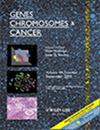EWSR1 Rearrangements in Basaloid Neoplasms With Adnexal Differentiation
Abstract
Various cutaneous adnexal neoplasms have been associated with gene fusions as the main driver of their histogenesis, most of which showed poroid or hidradenomatous differentiation or represented other tumors of sweat glands. Recently, we encountered two cases of primitive basaloid neoplasms of predominantly folliculogenic/pilosebaceous origin, both surprisingly harboring recurrent EWSR1 rearrangements. Both tumors presented in young patients of either sex (1 F; 17 years; 1 M; 37 years) and involved the dermis and subcutaneous tissue of the abdominal wall (case 1) and the buttock (case 2). Histologically, the tumors were composed of primitive, basaloid cells with areas of keratinization (case 1) or foci of sebaceous differentiation (case 2) and stained strongly with keratins, p40 (case 1) or p63 (case 2), while lacking significant CD99 expression in both cases. Case 1 harbored an EWSR1::FLI1 fusion while case 2 harbored an EWSR1::PBX3 fusion. Clinical follow-up was available for case 2 and showed no evidence of disease at 15 months of follow-up. Methylation profiling showed case 1 to cluster with cutaneous squamous cell carcinoma, while case 2 was independent but positioned close to salivary gland epithelial-myoepithelial carcinoma. These findings expand on the histopathologic and molecular genetic features of basaloid tumors with apparent adnexal differentiation and raise awareness to carefully interpret and correlate molecular findings with morphology and immunophenotype to avoid misinterpretation as a mesenchymal neoplasm.

 求助内容:
求助内容: 应助结果提醒方式:
应助结果提醒方式:


